Italian war crimes
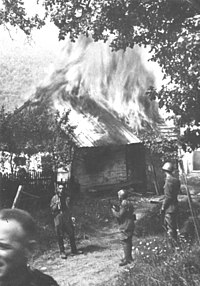
Italian war crimes have mainly been associated with Fascist Italy in the Pacification of Libya, the Second Italo-Ethiopian War, Spanish Civil War, and World War II.
Italo-Turkish War[]
In 1911, Italy went to war with the Ottoman Empire and invaded Ottoman Tripolitania. One of the most notorious incidents during this conflict was the October Tripoli massacre, wherein many civilian inhabitants of the Mechiya oasis were killed over a period of three days as retribution for the execution and mutilation of Italian captives taken in an ambush at nearby Sciara Sciat. In 1912, 10,000 Turkish and Arab troops were imprisoned in concentration camps in Libya, all Turkish troops were executed.
Pacification of Libya[]
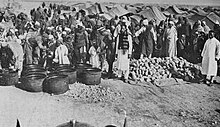
In 1923, Mussolini embarked upon a campaign to consolidate control over the Italian territory of Libya and Italian forces began occupying large areas of Libya to allow for rapid settlement by Italian colonists. They were met with resistance by the Senussi who were led by Omar Mukhtar. Civilians suspected of collaboration with the Senussi were executed. Refugees from the fighting were subject to bombing and strafing by Italian aircraft. In 1930, in northern Cyrenaica, 20,000 Bedouins were relocated and their land was given to Italian settlers. The Bedouins were forced to march across the desert into concentration camps. Starvation and other poor conditions in the camps were rampant and the internees were used for forced labour, ultimately leading to the death of nearly 4,000 internees by the time they were closed in September 1933.[1] Over 80,000 Cyrenaicans died during the Pacification in all.[2][3]
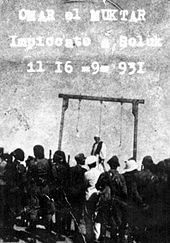
Second Italo-Ethiopian War[]
During the Second Italo-Ethiopian War, Italian violations of the laws of war were reported and documented.[4] These included the use of chemical weapons such as mustard gas, the use of concentration camps in counter-insurgency, and attacks on Red Cross facilities.[5] Italian authorities claimed that these actions were in response to the Ethiopians' use of Dum-Dum bullets, which had been banned by declaration IV, 3 of the Hague Convention, and mutilation of captured soldiers.[6][7]
According to the Ethiopian government, 382,800 civilian deaths were directly attributable to the Italian invasion. 17,800 women and children killed by bombing, 30,000 people were killed in the massacre of February 1937, 35,000 people died in concentration camps, and 300,000 people died of privations due to the destruction of their villages and farms. The Ethiopian government also claimed that the Italians destroyed 2,000 churches and 525,000 houses, while confiscating or slaughtering 6 million cattle, 7 million sheep and goats, and 1.7 million horses, mules, and camels, leading to the latter deaths.[8]
During the 1936–1941 Italian occupation, atrocities also occurred; in the February 1937 Yekatit 12 massacres as many as 30,000 Ethiopians may have been killed and many more imprisoned as a reprisal for the attempted assassination of Viceroy Rodolfo Graziani. A 2017 study estimated that 19,200 were killed - a fifth of the population of Addis Ababa. The Ethiopian Orthodox Tewahedo Church was especially singled out. Thousands of Ethiopians also died in concentration camps such as Danane and Nocra.
Spanish Civil War[]
75,000 Italian soldiers of the Corpo Truppe Volontarie fought on the side of the Nationalists during the Spanish Civil War, as did 7,000 men of the Aviazione Legionaria. While they also bombed valid military targets such as the railway infrastructure of Xativa, the Italian air force partook in many bombings of civilian targets for the purposes of "weakening the morale of the Reds". One of the more notable bombings was the Bombing of Barcelona, in which 1,300 civilians were killed, with thousands more being wounded or dehoused.[9] Other cities subjected to terror bombing by the Italians included Durango, Alicante, Granollers, and Guernica.
Documents found in British archives by the historian Effie Pedaliu[10] and documents found in Italian archives by the Italian historian Davide Conti,[11] pointed out that the memory of the existence of the Italian concentration camps and Italian war crimes committed during the Spanish Civil War had been repressed due to the Cold War.
World War II[]
The British and American governments, fearful of the post-war Italian Communist Party, effectively undermined the quest for justice by tolerating the efforts made by Italy's top authorities to prevent any of the alleged Italian war criminals from being extradited and taken to court.[12][10] Fillipo Focardi, a historian at Rome's German Historical Institute, has discovered archived documents showing how Italian civil servants were told to avoid extraditions. A typical instruction was issued by the Italian prime minister, Alcide De Gasperi, reading: "Try to gain time, avoid answering requests."[12] The denial of Italian war crimes was backed up by the Italian state, academe, and media, re-inventing Italy as only a victim of the German Nazism and the post-war Foibe massacres.[12]
A number of suspects, known to be on the list of Italian war criminals that Yugoslavia, Greece and Ethiopia requested an extradition of, at the end of World War II never saw anything like the Nuremberg trial, because with the beginning of the Cold War, the British government saw in Pietro Badoglio, who was also on the list, a guarantee of an anti-communist post-war Italy.[12][10][13][14]
Yugoslavia[]


In April 1941, Italy invaded Yugoslavia, occupying large portions of Slovenia, Croatia, Bosnia, Montenegro, Serbia and Macedonia, while directly annexing to Italy the Ljubljana Province, Gorski Kotar and Central Dalmatia, along with most Croatian islands. To suppress the mounting resistance led by the Slovenian and Croatian Partisans, the Italians adopted tactics of "summary executions, hostage-taking, reprisals, internments and the burning of houses and villages.".[15]
In May 1942 Mussolini told Mario Roatta, commander of the Italian 2nd Army, that "the best situation is when the enemy is dead. So we must take numerous hostages and shoot them whenever necessary." To implement this Roatta suggested the closure of the Fiume province and Croatia, the evacuation of people in the east of the former frontiers to a distance of 3–4 km inland, the organization of border patrols to kill anyone attempting to cross, the mass internment of "twenty to thirty thousand persons" to Italian concentration camps, burning down houses, and the confiscation of property from villagers suspected of having contact with Partisans for families of Italian soldiers. He also mentioned the need to extend the plan to Dalmatia and for the construction of concentration camps.[16] Roatta insisted, "If necessary don't shy away from using cruelty. It must be a complete cleansing. We need to intern all the inhabitants and put Italian families in their place."[17]
Italian concentration camps[]
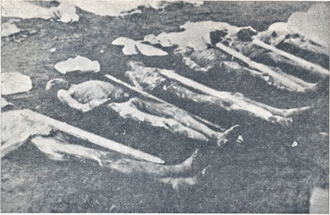
In the Province of Ljubljana, alone, the Italians sent some 25,000 to 40,000[18] Slovene civilians to concentrations camps, which equaled 7.5% to 12% of its total population. The Italians also sent tens-of-thousands of Croats, Serbs, Montenegrins and others to concentration camps, including many women and children. The operation, one of the most drastic in Europe, filled up many Italian concentration camps, such as Rab, Gonars, Monigo, Renicci di Anghiari, Molat and elsewhere. Among the 10,619 civilians held in October 1942 in just the Rab concentration camp, 3,413 were women and children, with children accounting for 1,422 of the prisoners.[19] Over 3,500 internees died at Rab alone, including at least 163 children listed by name,[20] giving it a mortality rate of 18%.[21] Concentration camp survivors received no compensation from the Italian state after the war.
Mass killings of civilians[]
In early July 1942, Italian troops operating opposite Fiume, were reported to have shot and killed 800 Croat and Slovene civilians and burned down 20 houses near Split on the Dalmatian coast.[22] Massacres in this region included the infamous reprisal in Podhum.[23] Later that month, the Italian Air Force was reported to have practically destroyed four Yugoslav villages and killed hundreds of civilians in revenge for a local guerrilla attack that resulted in the death of two high-ranking officers.[24] In the second week of August 1942, Italian troops were reported to have burned down six Croatian villages and shot dead more than 200 civilians in retaliation for guerrilla attacks.[25] In September 1942, the Italian Army was reported to have destroyed 100 villages in Slovenia and killed 7,000 villagers in reprisal for local guerrilla attacks.[26]
On 16 November 1942, after a Partisan attack on a military truck convoy, Italian forces launched a combined and indiscriminate land, air and naval bombardment targeting the small town of Primošten in reprisal. Some 150 civilians were killed in the attack, nearby villages were also burned and 200 citizens were arrested.[27]
Other anti-Partisan repressive measures[]
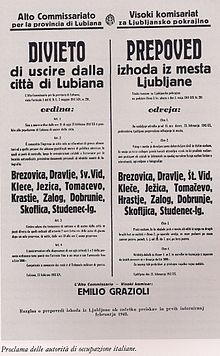
On their own, or with their Nazi allies, the occupying Italian army undertook many armed actions, including brutal offensives intended to wipe out Partisan resistance. This included Case White in Bosnia, in which German, Italian and allied quisling forces killed 12,000 Partisans, plus 3,370 civilians, while sending 1,722 civilians to concentration camps. During the Case Black offensive, German, Italian and allied troops killed 7,000 Partisans (two-thirds of the total 22,000 Partisan force were killed or wounded), and executed 2,537 civilians.
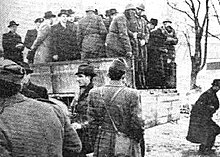
In Ljubljana Province, in July 1941, the Italian army assembled 80,000 well-armed troops to attack 2,500-3,000 poorly armed Partisans,[28] who had liberated large portions of the Province. Italian general Mario Robotti issued commands for all persons caught with arms or false identification papers to be shot on the spot, while most other men of military age were to be sent to concentration camps.[29] All buildings from which shots were fired on Italian troops, or in which ammunition was found, or the owners showed hospitality to Partisans, were to be destroyed. Italian troops were ordered to burn crops, kill livestock and burn villages which supported Partisans.[29] To destroy the resistance, the Italian occupiers also completely surrounded the capital city of Ljubljana with barbed wire, bunkers and control points. Civilians, particularly families of partisans and their supporters, were sent by the tens-of-thousands to Italian concentration camps, and in a meeting in Gorizia in July 1942, between Italian generals and Mussolini, they agreed to forcefully deport all 330,000 inhabitants of Ljubljana Province, if necessary, and replace them with Italians.[28]
None of the Italians responsible for the many war crimes against Yugoslavs - including Generals Roatta and Robotti, Fascist Commissar Emilio Grazioli, etc - were ever brought to trial.
Greece[]
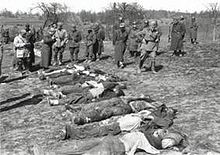
A similar phenomenon took place in Greece in the immediate postwar years. The Italian occupation of Greece was often brutal, resulting in reprisals such as the Domenikon Massacre.[30] The Greek government claimed that Italian occupation forces destroyed 110,000 buildings and via various causes inflicted economic damage of $6 billion (1938 exchange rates)[31] while executing 11,000 civilians; in terms of the percentage of direct and indirect destruction this was almost identical to the figures attributed to German occupation forces.[32] The Italians also presided over the Greek famine while occupying the majority of the country, and along with the Germans were responsible for it by initiating a policy of wide-scale plunder of everything of value in Greece, including food for its occupation forces. Ultimately, the Greek famine led to the deaths of 300,000 Greek civilians.[33] Pope Pius XII, in a contemporary letter, directly blamed the Fascist Italian government for the deaths in addition to the Germans: "Axis authorities in Greece are robbing the starving population of their entire harvest of corn, grapes, olives, and currants; even vegetables, fish, milk, and butter are being seized... Italy is the occupying power and Italy is responsible for the proper feeding of the Greek people... after the war the story of Greece will be an indelible blot on the good name of Italy, at any rate Fascist Italy."[34]
After two Italian filmmakers were jailed in the 1950s for depicting the Italian invasion of Greece and the subsequent occupation of the country as a "soft war", the Italian public and media were forced to repress their collective memory. The repression of memory led to historical revisionism[35] in Italy and in 2003, the Italian media published Silvio Berlusconi's statement that Benito Mussolini only "used to send people on vacation".[36][37]
List of Italian war criminals[]
This is a working list of Italian high-ranking military personnel or other officials involved in acts of war. It includes also such personnel of lower rank that were accused of grave breaches of the laws of war. Inclusion of a person does not imply that the person was qualified as a war criminal by a court of justice. As noted in the relevant section, very few cases have been brought to court due to diplomatic activities of, notably, the government of the United Kingdom and subsequent general abolition.
The criterion for inclusion in the list is the existence of reliable documented sources.
- Benito Mussolini: In 1936, during the Second Italo-Ethiopian War, Mussolini ordered the manufacturing/purchase of hundreds of tons of yperite, phosgene, and fire munitions in the form of aerial bombs and artillery and mortar shells.[citation needed]
- Pietro Badoglio: In 1936, during the Second Italo-Ethiopian War, Badoglio approved, as commander in chief of the Italian army, the use of poisonous gas against enemy troops.[citation needed]
- Rodolfo Graziani: In 1950, a military tribunal sentenced Graziani to prison for a term of 19 years (but released after a few months) as punishment for his collaboration with the Nazis, when he was Minister of Defense of the Italian Social Republic. He was a key figure in the Pacification of Libya and authorized the mass killing of Ethiopians known as Yekatit 12.[citation needed]
- Alessandro Pirzio Biroli: The Governor of the Italian governorate of Montenegro, he ordered that fifty Montenegrin civilians be executed for every Italian killed, and ten be executed for every Italian wounded.
- Mario Roatta: In 1941–1943, during the 22-month existence of the Province of Ljubljana, Roatta ordered the deportation of 25,000 people, which equaled 7.5% of the total population. The operation, one of the most drastic in Europe, filled up Italian concentration camps on the island of Rab, in Gonars, Monigo (Treviso), Renicci d'Anghiari, Chiesanuova and elsewhere. The survivors received no compensation from the Italian state after the war. He had, as the commander of the 2nd Italian Army in Province of Ljubljana, ordered besides internments also summary executions, hostage-taking, and burning of houses and villages,[39][40] for which after the war the Yugoslav government sought unsuccessfully to have him extradited for war crimes. He was quoted as saying "Non dente per dente, ma testa per dente" ("Not a tooth for tooth but a head for a tooth"), while Robotti was quoted as saying "Non si ammazza abbastanza!" ("There are not enough killings") in 1942.[41] "On 1 March 1942, he (Roatta) circulated a pamphlet entitled '3C' among his commanders that spelled out military reform and draconian measures to intimidate the Slav populations into silence by means of summary executions, hostage-taking, reprisals, internments and the burning of houses and villages. By his reckoning, military necessity knew no choice, and law required only lip service. Roatta's merciless suppression of partisan insurgency was not mitigated by his having saved the lives of both Serbs and Jews from the persecution of Italy's allies Germany and Croatia. Under his watch, the 2nd Army's record of violence against the Yugoslav population easily matched the German. Tantamount to a declaration of war on civilians, Roatta's '3C' pamphlet involved him in war crimes."[40] One of Roatta's soldiers wrote home on July 1, 1942: "We have destroyed everything from top to bottom without sparing the innocent. We kill entire families every night, beating them to death or shooting them."[42] As noted by Minister of Foreign Affairs in Mussolini government, Galeazzo Ciano, when describing a meeting with secretary general of the Fascist party who wanted Italian army to kill all Slovenes:
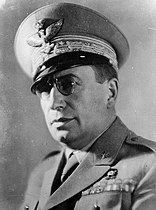 Mario Roatta (1887–1968): Italian General Accused of War Crimes and called "The Beast" in Yugoslavia.[38]
Mario Roatta (1887–1968): Italian General Accused of War Crimes and called "The Beast" in Yugoslavia.[38](...) I took the liberty of saying they (the Slovenes) totaled one million. It doesn't matter – he replied firmly – we should model ourselves upon ascari (auxiliary Eritrean troops infamous for their cruelty) and wipe them out".[43]
- Mario Robotti, Commander of the Italian 11th Division in Slovenia and Croatia, issued an order in line with a directive received from Mussolini in June 1942: "I would not be opposed to all (sic) Slovenes being imprisoned and replaced by Italians. In other words, we should take steps to ensure that political and ethnic frontiers coincide.",[44] which qualifies as ethnic cleansing policy.
- Nicola Bellomo was an Italian general who was tried and found guilty for killing a British prisoner of war and wounding another in 1941. He was one of the few Italians to be executed for war crimes by the Allies, and the only one executed by a British-controlled court.
- Italo Simonitti, a captain in the Italian Social Republic's 4th Monterosa Alpine division, was executed for his involvement in the 1945 execution of an American prisoner.
- Pietro Caruso was chief of the Fascist police in Rome while it was occupied by the Germans. He helped organize the Ardeatine massacre in March 1944. After Rome was liberated by the Allies he was tried that September and subsequently executed by the co-belligerent Italian government.
- Guido Buffarini Guidi was the Minister of the Interior for the Italian Social Republic; shortly after the end of the war in Europe he was found guilty of war crimes and executed by the co-belligerent government.
- Pietro Koch was head of the Banda Koch, a special task force of the Corpo di Polizia Repubblicana dedicated to hunting down partisans and rounding up deportees. His ruthless extremism was cause for concern even to his fellow fascists, who had him arrested in October 1944. When he came into Allied captivity he was convicted of war crimes and executed.
A number of names of Italians can be found in the CROWCASS list established by the Anglo-American Allies of the individuals wanted by Yugoslavia and Greece for war crimes.[45][46]
See also[]
- Italian Fascism
- Italian Fascism and racism
- Anti-Italianism
- Internment of Italian Americans
- Italian Civil War
- List of war crimes
- Allied war crimes during World War II
- British war crimes
- German war crimes
- Japanese war crimes
- Soviet war crimes
- United States war crimes
References[]
- ^ Duggan, Christopher (2007). The Force of Destiny: A History of Italy Since 1796. New York: Houghton Mifflin. pp. 496–497.
- ^ Mann, Michael (2006). The Dark Side of Democracy: Explaining Ethnic Cleansing. Cambridge University Press. p. 309. ISBN 9780521538541.
- ^ Ahmida, Ali Abdullatif (23 March 2011). Making of Modern Libya, The: State Formation, Colonization, and Resistance, Second Edition. SUNY Press. p. 146. ISBN 9781438428932.
- ^ Effie G. H. Pedaliu (2004) Britain and the 'Hand-over' of Italian War Criminals to Yugoslavia, 1945–48. Journal of Contemporary History. Vol. 39, No. 4, Special Issue: Collective Memory, pp. 503–529 JSTOR 4141408
- ^ Rainer Baudendistel, Between bombs and good intentions: the Red Cross and the Italo-Ethiopian War, 1935-1936, Berghahn Books, 2006, p.239; 131-2. Google books link
- ^ League of Nations
- ^ [1]
- ^ Barker, A. J. (1968). The Civilising Mission: The Italo-Ethiopian War 1935–6. London: Cassell. ISBN 978-0-304-93201-6. Pages 292-293.
- ^ 1931-2017., Thomas, Hugh, (2003). The Spanish Civil War (4th ed.). London: Penguin. ISBN 9780141011615. OCLC 53806663.
- ^ Jump up to: a b c Effie Pedaliu (2004) Britain and the 'Hand-over' of Italian War Criminals to Yugoslavia, 1945–48. Journal of Contemporary History. Vol. 39, No. 4, Special Issue: Collective Memory, pp. 503–529 JSTOR 4141408
- ^ Conti, Davide (2011). "Criminali di guerra Italiani". Odradek Edizioni. Retrieved 2012-10-14.
- ^ Jump up to: a b c d Italy's bloody secret (Archived by WebCite®), written by Rory Carroll, Education, The Guardian, June 2001
- ^ Oliva, Gianni (2006) «Si ammazza troppo poco». I crimini di guerra italiani. 1940–43, Mondadori, ISBN 88-04-55129-1
- ^ Baldissara, Luca & Pezzino, Paolo (2004). Crimini e memorie di guerra: violenze contro le popolazioni e politiche del ricordo, L'Ancora del Mediterraneo. ISBN 978-88-8325-135-1
- ^ General Roatta's War against the Partisans in Yugoslavia: 1942, IngentaConnect
- ^ Rodogno 2006, p. 337.
- ^ Steinberg 2002, p. 34.
- ^ Tomasevich, Jozo (2002). War and Revolution in Yugoslavia: 1941 - 1945. Stanford University Press. p. 104. ISBN 978-0-8047-7924-1.
- ^ Rodogno, Davide (2003). Il nuovo ordine mediterraneo: le politiche di occupazione dell'Italia fascista in Europa (1940-1943) (in Italian). Bollati Boringhieri. ISBN 978-88-339-1432-9.
- ^ "Talijanski fašistički logor Kampor - Udruga antifašista Rab". www.ua-rab.hr. Retrieved 2020-07-18.
- ^ Cresciani, Gianfranco (2004) Clash of civilisations, Italian Historical Society Journal, Vol.12, No.2, p.7
- ^ Report Italians Execute 800 in Yugoslavia
- ^ Tomasevich 2001, p. 134.
- ^ Italians Level Slav Villages In Reprisal
- ^ ITALIANS BURN 6 CROAT TOWNS
- ^ Italians Raze 100 Sloven Villages
- ^ Tomasevich 2001, pp. 134–135.
- ^ Jump up to: a b Tomasevich, Jozo (2002). War and Revolution in Yugoslavia, 1941-1945: Occupation and Collaboration. Stanford University Press. p. 106. ISBN 978-0-8047-7924-1.
- ^ Jump up to: a b Tomasevich, Jozo (2002). War and Revolution in Yugoslavia, 1941-1945: Occupation and Collaboration. Stanford University Press. p. 105. ISBN 978-0-8047-7924-1.
- ^ P. Fonzi, “Liquidare e dimenticare il passato”: i rapporti italo – greci tra il 1943 e il 1948, in “Italia Contemporanea”, 266 (2012), pp. 7–42
- ^ Constantine A. Doxiadis, "Destruction of Towns and Villages in Greece." Series of Publications of the Ministry of Reconstruction, no.11 (Athens: Ministry of Reconstruction, 1947), p.59. The 112 GRD/USD conversion can be worked out from p.63.
- ^ Doxiadis, Sacrifices of Greece, Claims and Reparations, no.19, p.75-77
- ^ Baranowski, Shelley (2010). Nazi empire: German colonialism and imperialism from Bismarck to Hitler. Cambridge: Cambridge University Press. p. 273. ISBN 978-0-521-67408-9.
- ^ Margherita, Marchione. "Pope Pius XII: Architect for Peace." Paulist Pr, May 2000. Page 280.
- ^ Alessandra Kersevan 2008: (Editor) Foibe – Revisionismo di stato e amnesie della repubblica. Kappa Vu. Udine.
- ^ Survivors of war camp lament Italy's amnesia, 2003, International Herald Tribune
- ^ Di Sante, Costantino (2005) Italiani senza onore: I crimini in Jugoslavia e i processi negati (1941–1951), Ombre Corte, Milano. (Archived by WebCite®)
- ^ Britain, Italy and the Origins of the Cold War. Author: E. Pedaliu. Springer, 2003, page 13, ISBN 9780230597402 Adicionado em 20/05/2018.
- ^ Giuseppe Piemontese (1946).Twenty-nine months of Italian occupation of the Province of Ljubljana, page 10.
- ^ Jump up to: a b James H. Burgwyn (2004). General Roatta's war against the partisans in Yugoslavia: 1942, Journal of Modern Italian Studies, Volume 9, Number 3, pp. 314–329(16)
- ^ Gianni, Oliva (2007) "Si ammazza troppo poco". I crimini di guerra italiani 1940–1943, Mondadori.
- ^ James Walston, a historian at The American University of Rome. Quoted in Rory, Carroll. Italy's bloody secret. The Guardian. (Archived by WebCite®), The Guardian, London, UK, June 25, 2003
- ^ The Ciano Diaries 1939–1943: The Complete, Unabridged Diaries of Count Galeazzo Ciano, Italian Minister of Foreign Affairs, 1936–1943 (2000) ISBN 1-931313-74-1
- ^ Tommaso Di Francesco, Giacomo Scotti (1999) Sixty years of ethnic cleansing, Le Monde Diplomatique, May Issue.
- ^ The Central Registry of War Criminals and Security Suspects, Consolidated Wanted Lists, Part 2 - Non-Germans only (March 1947), Uckfield 2005 (Naval & University Press); pp. 56–74
- ^ The Central Registry of War Criminals and Security Suspects, Supplementary Wanted List No. 2, Part 2 - Non Germans (September 1947), Uckfield 2005 (Naval & University Press); pp. 81–82
Sources[]
- Giuseppe Piemontese (1946): Twenty-nine months of Italian occupation of the Province of Ljubljana
- Michael Palumbo, L'olocausto rimosso, Milano, Rizzoli, 1992
- Lidia Santarelli: "Muted violence: Italian war crimes in occupied Greece", Journal of Modern Italian Studies, September 2004, vol. 9, no. 3, pp. 280–299(20); Routledge, part of the Taylor & Francis Group doi:10.1080/1354571042000254728
- Effie Pedaliu (2004): Britain and the ‘Hand-Over’ of Italian War Criminals to Yugoslavia, 1945–48, Journal of Contemporary History, Vol. 39, No. 4, 503–529 JSTOR 4141408
- Pietro Brignoli (1973): messa per i miei fucilati[permanent dead link], Longanesi & C., Milano,
- H. James Burgwyn (2004): "General Roatta's war against the partisans in Yugoslavia: 1942", Journal of Modern Italian Studies, September vol. 9, no. 3, pp. 314–329(16) doi:10.1080/1354571042000254746
- Gianni Oliva (2006): 'Si ammazza troppo poco'. I crimini di guerra italiani 1940–43. ('There are too few killings'. Italian war crimes 1940–43), Mondadori, ISBN 88-04-55129-1
- Alessandra Kersevan (2003): "Un campo di concentramento fascista. Gonars 1942–1943", Comune di Gonars e Ed. Kappa Vu,
- Alessandra Kersevan (2008): Lager italiani. Pulizia etnica e campi di concentramento fascisti per civili jugoslavi 1941–1943. Editore Nutrimenti,
- Alessandra Kersevan 2008: (Editor) Foibe – Revisionismo di stato e amnesie della repubblica. Kappa Vu. Udine.
- Luca Baldissara, Paolo Pezzino (2004). Crimini e memorie di guerra: violenze contro le popolazioni e politiche del ricordo. ISBN 978-88-8325-135-1
- The Central Registry of War Criminals and Security Suspects (CROWCASS) - Consolidated Wanted Lists (1947), Uckfield 2005 (Naval & University Press, facsimile edition of the original document at the National Archives in Kew/London)
- Italian Crimes In Yugoslavia (Yugoslav Information Office – London 1945)
- Mass internment of civil population under inhuman conditions – Italian concentration camps
- Italian war crimes
- War crimes committed by country
- Human rights abuses in Italy
